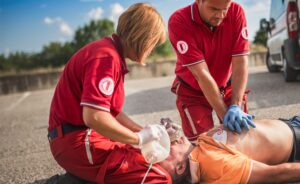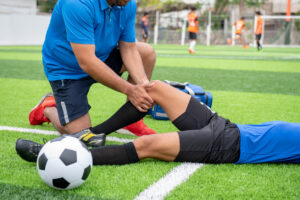Back to: Physical Health Education SS2
Welcome to today’s class!!
We are thrilled to have you in our class!!
In today’s Physical and Health Education class, we will be focusing on Revision
Revision
First Aid

First aid is vital for saving lives. A person can carry out first aid after a life-threatening incident or injury before the arrival of emergency services.
Here are important things to know about First Aid:
- The aims of first aid are to preserve life, prevent harm, and promote recovery.
- In first aid, ABC stands for airway, breathing, and circulation.
- The recovery position helps minimize further injury.
- CPR stands for cardiopulmonary resuscitation. It helps maintain the flow of oxygenated blood.
- While doing chest compressions, you may hear cracks. This is normal!
Aims Of First Aid
The aims of first aid are:
- To preserve life: Saving lives is the main aim of first aid.
- To prevent further harm: The person who has experienced the injury must be kept stable, and their condition must not deteriorate before medical services arrive. This may include moving the individual away from harm, applying first aid techniques, keeping them warm and dry, and applying pressure to wounds to stop any bleeding.
- Promote recovery: Taking steps to promote recovery may include applying a bandage to a wound.
How To Practice First Aid
The most common term referred to in first aid is ABC. This stands for airway, breathing, and circulation. A fourth step will appear in the emergency procedures for some facilities.
- Airway: Make sure the airway is clear. Choking, which results from the obstruction of airways, can be fatal.
- Breathing: Once the airways are confirmed to be clear, determine whether the person can breathe, and, if necessary, provide rescue breathing.
- Circulation: If the person involved in the emergency situation is not breathing, the first aider should go straight for chest compressions and rescue breathing. The chest compressions will promote circulation. This saves valuable time. In emergencies that are not life-threatening, the first aider needs to check the pulse.
Sports Injuries

Injuries occur during exercise or while participating in a sport. Children are particularly at risk for these types of injuries, but adults can get them, too.
How then can sports injuries affect you? Let’s find out!
You’re at risk for sports injuries if you:
- haven’t been regularly active
- don’t warm up properly before exercise
- play contact sports
Types Of Sports Injuries
Different sports injuries produce different symptoms and complications. The most common types of sports injuries include:
- Sprains. Overstretching or tearing the ligaments results in a sprain. Ligaments are pieces of tissue that connect two bones to one another in a joint.
- Strains. Overstretching or tearing muscles or tendons results in a sprain. Tendons are thick, fibrous cords of tissue that connect bone to muscle. Strains are commonly mistaken for sprains.
- Knee injuries. Any injury that interferes with how the knee joint moves could be a sports injury. It could range from an overstretch to a tear in the muscles or tissues in the knee.
- Swollen muscles. Swelling is a natural reaction to an injury. Swollen muscles may also be painful and weak.
- Achilles tendon rupture. The Achilles tendon is a thin, powerful tendon at the back of your ankle. During sports, this tendon can break or rupture. When it does, you may experience sudden, severe pain and difficulty walking.
Swimming
Before we start, here are interesting things to note about swimming:
- As well as being fun, swimming is a great way to keep fit and make friends.
- Swimming is a healthy activity that you can continue for a lifetime.
- Swimming is a low-impact activity that has many physical and mental health benefits.
The origin of swimming has some roots in what was referred to as, Competitive Swimming.
Competitive swimming continued to grow in popularity during the 1800s and was included in the first modern Olympic Games in Athens in 1896. In 1904, the Olympics in St. Louis included the 50-, 100-, 220-, 440-, 880-yard and one-mile freestyle, the 100-yard backstroke and 440-yard breaststroke, and a 4 x 50-yard freestyle relay.
By the 20th century, swimming had become very popular. Indoor pools were beginning to appear, most towns with populations over 20,000 had public outdoor pools, and swimming clubs became increasingly popular for recreation. Women participated for the first time in swimming in the Olympic Games in Stockholm in 1912, and Johnny Weissmuller became the first person to swim 100 meters in less than one minute.
Swimming For Recreation
Swimming is a great recreational activity for people of all ages. Recreational swimming can provide you with a low-impact workout and it’s a good way to relax and feel good.
Common swimming styles in recreational swimming are:
- breaststroke
- backstroke
- sidestroke
- freestyle.
Some people who enjoy swimming want to take it to a competitive level. This can provide the health benefits of a vigorous workout as well as the fun and thrill of competition.
The main strokes used in competitive swimming are:
- breaststroke
- freestyle
- backstroke
- butterfly.
The distances swum in competition swimming can vary from 50 meters in a pool to much further distances in open water.
Causes of Drowning

Drowning is described as death caused by suffocation when water or other liquid fills the lungs.
Drowning accidents can be prevented with precautions such as life jacket use and child supervision around water.
Let’s take a look at the most common causes of drowning and how to prevent these situations.
- Lack Of Swimming Ability
The most common cause of drowning is not knowing how to swim. Many adults and children will attempt to get into the water without proper swim training. Formal water safety and swimming lessons under the supervision of a lifeguard can dramatically decrease the risk of drowning.
- No Barriers Around The Pool
A four-sided fence separating the pool area from the house and yard reduces a child’s risk of drowning.
While installing a fence may not be cheap, it is certainly worth the life of a child. According to regulations, fences should have a locking mechanism and be tall enough to prevent wandering children from entering the pool area.
- Lack Of Supervision
Drowning can happen anywhere there is water. It is important to never leave a child unattended in or near a bathtub, pool, pond, or even a bucket of water. There should always be a lifeguard on duty or a competent supervising adult.
Also, whether you are old enough or not, never swim alone and follow the 10/20 rule: scan the area every 10 seconds and always be able to reach the water within 20 seconds.
- Failure To Wear Life Jackets
According to research, 72% of boating deaths that occurred during 2010 were caused by drowning, with 88% of victims not wearing life jackets. When boating, you should always have enough life jackets – adult and child-sized – for every person on the boat. Life jackets should be readily accessible and in good shape. It is best to insist everyone wear a life jacket at all times. You never know when an accident could occur.
- Alcohol Use
Alcohol use is involved in about 70% of water-related deaths among adolescents and adults. Alcohol affects the balance, coordination, judgment, and basic motor skills.
In summary, one’s ability to swim may be severely limited under the influence of alcohol, and they may not be able to accurately judge how long or how far they can swim.
Evaluation
Explain what a First Aid is and how to administer first aid.
Reading Assignment
Identify four types of Sports Injuries.
Weekend Assignment
Give five benefits of swimming
We hope you enjoyed today’s class. See you in the next class!
Let us know your thoughts and questions in the comment section, and we will attend to them as fast as we can.rev
